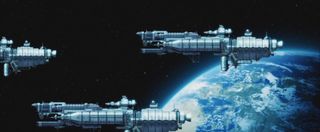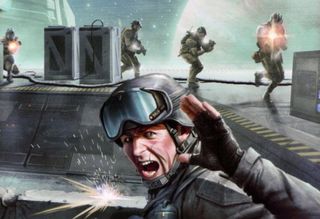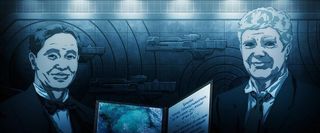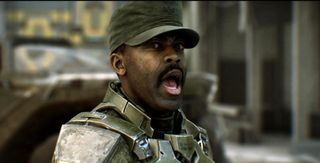Halo timeline: Rise of humanity and the Spartan program
After a complete defeat at the hands of the Forerunners in the ancient times, humanity grew to rebuild and once again thrive on Earth — and beyond. This is the story of the rise of humanity in Halo's current era.

In our last article, we took a look at how the fearsome and formidable Covenant empire expanded and increased its sphere of influence from the ancient years all the way until the modern era of the Halo timeline.
Complete Halo timeline series
In this installment, we're going to shift gears and examine the rise of humans following our defeat in ancient times and how the infamous Spartans of the Halo universe came to be.
Prelude: Rebuilding from the ashes

Humanity was forced to re-evolve following our punishment at the hands of the Forerunners in ancient times.
Most of human history in Halo happened as it did in our own world. After we were devolved by the Forerunners due to our foray into their territory eons prior, humanity had to advance themselves once again. Starting as cave dwellers and hunter gatherers, the human race would go on to experience several periods of cultural, industrial, societal, and agricultural revolution that led us to the invention of space travel in the twentieth century.
As the twenty-first century began, many hoped that the ability to traverse the universe beyond Earth would mean that new planets would be explored and colonized. However, that would not be the case in the Sol system. The other planets could only serve as homes to exploratory or military bases; they were not suitable for long-term living. By the end of the twenty-first century, Earth was woefully overpopulated. In order to maintain order between nations and planets alike, the Unified Earth Government (UEG) and United Nations Space Command (UNSC) were created.
2160 CE (Current Era): The Interplanetary Wars break out

Violent conflict broke out due to the constant struggles of an overpopulated species.
Despite the best efforts of the UEG and UNSC throughout the twenty-second century, several politically-motivated nations declared war on all who opposed them and began fighting. Communism and fascism saw a large resurgence in this time; due to the overpopulation of Earth, most groups sought to take control and bring others under their political and economic reign in order to (in their minds) save humanity. Due to the fact these conflicts spanned the Sol system, they were dubbed the Interplanetary Wars.
These conflicts spanned 10 entire years. When the UEG and the UNSC finally were able to stop the fighting on all sides, the United Nations convened and decided that the UEG would become the ultimate leading government for humanity, and all nations were to unite under it. The UNSC would serve as humanity's military, and act as the military arm of the UEG. Despite achieving peace, however, there was still no viable solution to the overpopulation problem — and it only continued to worsen.
Get the Windows Central Newsletter
All the latest news, reviews, and guides for Windows and Xbox diehards.
2291 CE: Accessing slipspace is achieved

The ability to access slipspace allowed for humanity to finally expand beyond the Sol system.
Humanity continued to suffer in the Sol system for almost 150 years after the end of the Interplanetary Wars. However, the future looked bright after the invention of the Shaw-Fujikawa translight engine in 2291. Scientists Tobias Shaw and Wallace Fujikawa were able to build a drive that could "tear open" a hole to slipspace, which is a sort of separate dimension in which faster-than-light travel can be achieved without most of the negative side effects that would normally occur.
This breakthrough could not have come at a better time. Armed with the ability to now quickly traverse light years, humanity began to explore the galaxy around the Sol system and colonize suitable worlds. This effectively took the pressure off of Earth and allowed humanity access to many materials that were often scarce; for example, the planet Reach contained a very large amount of titanium, something that none of the Sol planets had much of.

As time went on and expansions continued, the vast amount of newly colonized worlds were separated into two groups: the Inner Colonies and the Outer Colonies. Planets near Earth and the Sol system were considered Inner Colonies. These planets were where government officials were located, where economics were regulated, and where most research was conducted. As such, these planets were home to the wealthiest members of the human race.
The Outer Colonies, however, were home to the lower classes of society. The majority of the poor lived in the Outer Colonies, performing almost all of the agricultural and mining work for humanity. Often times, members of the Outer Colonies felt that they were being given the "short end of the stick" by the UEG and the Inner Colonies, and this led to a general dislike for them by Outer Colonies inhabitants.
2494 CE: The Insurrection begins

The Insurrectionists aimed to wrest control of the Outer Colonies away from the UEG and UNSC.
What started as a bitter opinion towards the UEG eventually turned into an all out rebellion by the Outer Colonies in 2494. Feeling that the UNSC and UEG failed to treat them fairly and that they regarded them as unimportant, the vast majority of the Outer Colonies banded together to form the Insurrection.
While not as well equipped, funded or trained as UNSC forces, the UNSC did not have a sufficient number of soldiers to counteract the Insurrection. When the UNSC met the Insurrectionists in open combat, victory was swift, but the Insurrectionists utilized terrorist guerilla tactics in order to do their damage, which was a strategy the UNSC could not effectively deal with at the time. As the years passed, civilian casualties (as well as heavy casualties on both sides) began to pile up. It was becoming clear this conflict would not end easily.

In order to attempt to resolve the war, the UNSC began the ORION project, with the goal of creating augmented super soldiers named Spartans to better combat the Insurrection. One notable member of this program is Sergeant Avery Johnson.
These soldiers proved to be very effective, but due to their small number, they couldn't be everywhere at once, which the Insurrection exploited. Though improved considerably, the UNSC's war effort still struggled to deliver decisive blows to the rebels.
2517 CE: Spartan-II Program launches

Dr. Catherine Halsey began work on a highly secret, controversial program in 2517 — the Spartan-II program. Abducting children at the age of six years old and replacing them with clones to fool their parents, she took 75 of them to the planet Reach and put them through rigorous mental and physical training, By age 14, they were as strong and fit as adult soldiers in their prime. The final step in the program, though, was augmentation. In 2525, they were given incredibly powerful (but dangerous) physical and mental enhancements.
These augmentations outright killed 30 of the Spartan-IIs and deformed another 12, leaving only 33 fully intact and battle ready.

As hoped, the Spartan-IIs, despite their small number, were extremely effective against the rebels. When paired with a massive UNSC offensive operation in 2525, they quickly eliminated much of the Insurrectionist leadership, crippling their operations and destabilizing their infrastructure. The Spartan-IIs overall proved to be the catalyst that the UNSC needed in order to (for the most part) quell the Insurrection.
Your thoughts
What do you think of the rise of humanity and their expansion across the stars? Are you enjoying our Halo timeline series? Let us know in the comments.
Brendan Lowry is a Windows Central writer and Oakland University graduate with a burning passion for video games, of which he's been an avid fan since childhood. You'll find him doing reviews, editorials, and general coverage on everything Xbox and PC. Follow him on Twitter.

